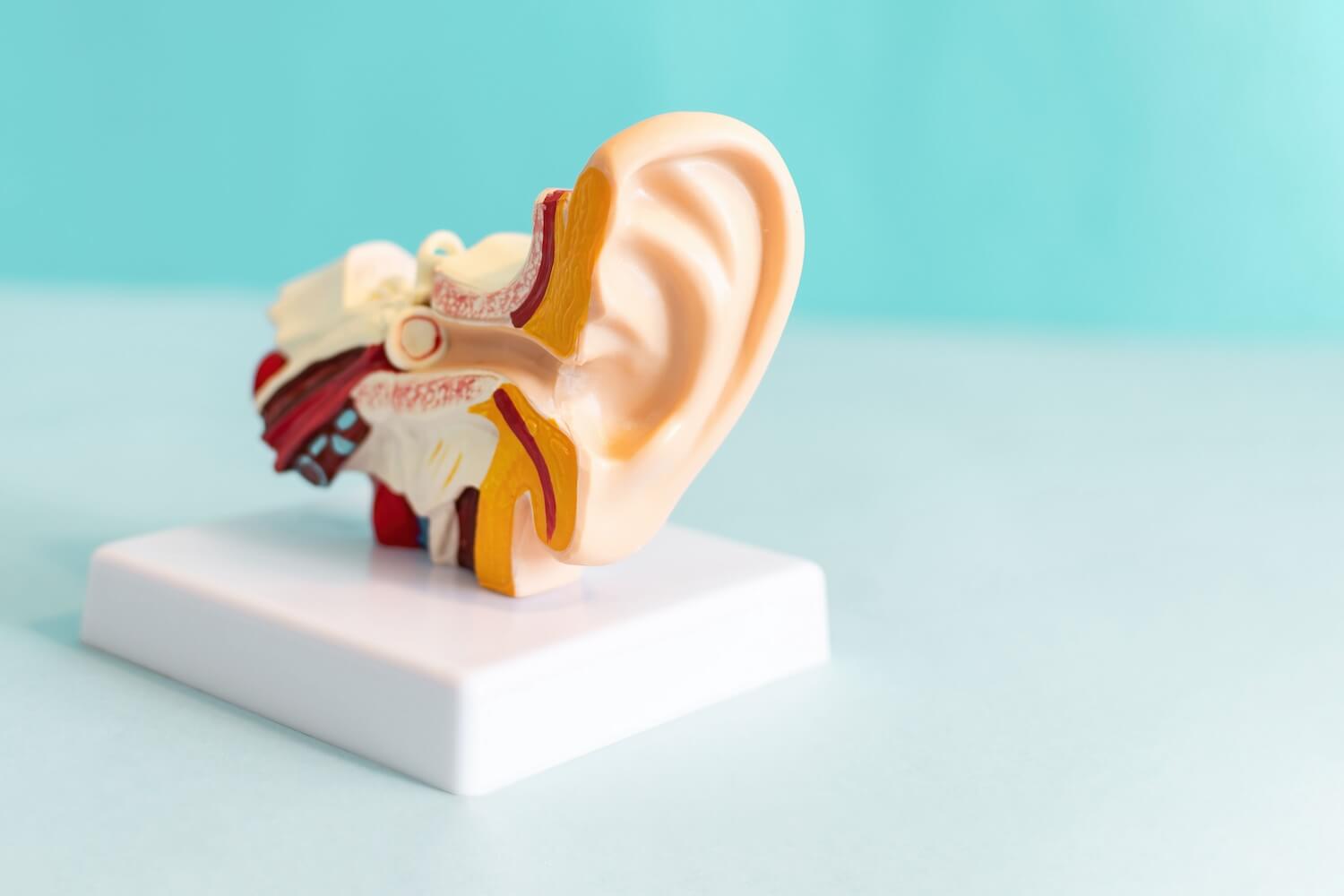
Behind-the-Ear (BTE)
- Suited for mild to profound hearing loss
- All components are housed behind the ear with a clear tube leading to an earpiece that fits inside your ear
- Modern hearing aids are sleeker and slimmer than older versions and are great for people with dexterity challenges or visual impairment.
- Feature powerful Bluetooth™ technology and typically have more options than in-the-ear hearing aids
4 Facts About Behind-the-Ear Hearing Aids
- More powerful and versatile than in-the-ear hearing aids
- Rechargeable battery options available
- Some users find the behind-the-ear placement more comfortable
- Can often connect to and stream wirelessly from smartphones, TVs and tablets
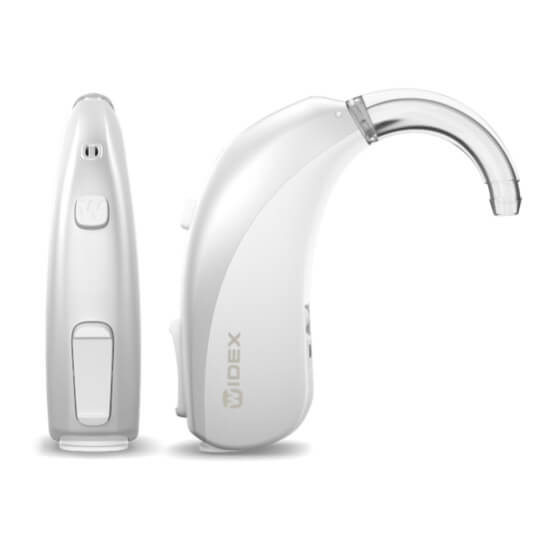
Behind-the-Ear (BTE) Hearing Aids “Thick Tubing”
In BTE hearing aids, all the electronic components—including the speaker—are contained within the body of the hearing aid, which is worn behind the ear. Sound from the speaker is sent down to the ear canal via a hollow tube, which protects the speaker from moisture and earwax within the ear canal.
Below is a BTE hearing aid with standard-width tubing and a custom-fitted earmold. The translucent earpiece is typically manufactured based on a silicone-putty “earmold”.
Most modern BTE hearing aids may be fit with either a thin or slightly larger standard tube. They may also use a custom earmold or smaller and lighter standard “dome,” an earpiece that fits within the ear canal. When hearing loss is not too severe and limited to higher pitches, BTE hearing aids are typically fitted with thin tubing and a standard canal dome.
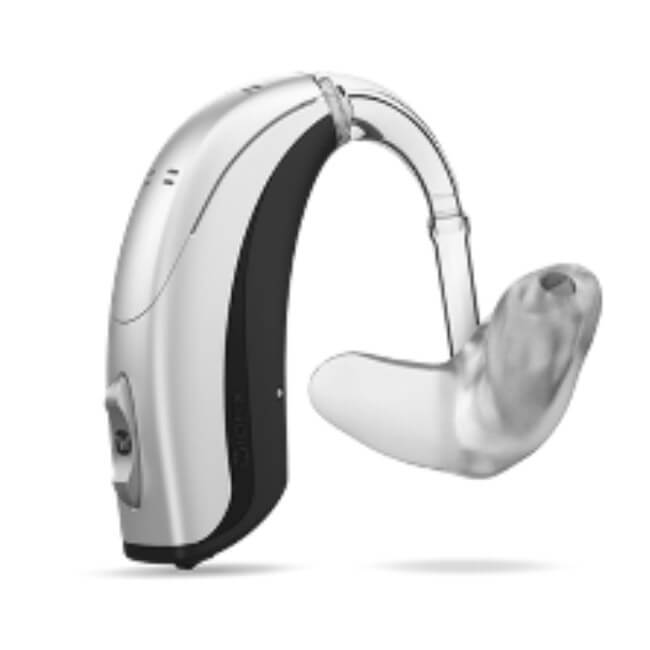
For more severe hearing losses, or when the lower pitches are affected, a custom earmold is typically used. Custom molds help to seal the ear canal to prevent feedback. Sealing the ear canal enables the hearing aid to deliver louder sound but unfortunately leads to reduced comfort.
Advantages of BTE Hearing Aids:
- Less susceptible to damage from moisture and earwax
- Can fit mild-to-profound hearing losses
- Can be fit with non-custom domes or custom earmolds
- Flexibility for worsening hearing loss easy to clean, handle, and use
- Longer battery life than smaller devices
- Minimal feedback
- Works well with directional microphones and telecoil
- They can be physically fit using a variety of generic rubber domes or with a custom earmold with appropriate venting on the end of the receiver wire.
- The receiver wires can be replaced and the amplification levels of RIC hearing aids can easily be increased should your hearing worsen without having to buy a whole new set of hearing aids.
Disadvantages of BTE Hearing Aids:
- Larger models may cause discomfort behind the ear and may be difficult for those who wear glasses.
- Custom earmolds that seal the ear canal may make the ear feel more plugged-up.
- Bulky and more visible than other styles
- Can pick up external noise like wind
- They are equipped with a single Omni-directional microphone that is sensitive to sounds arriving from all around you.
- Not a good fit for people that have poor vision or manual dexterity issues.
- Smaller surface area may cause feedback (e.g. whistling in hearing aid) due to acoustic leakage.
Behind-the-Ear (BTE) Options:
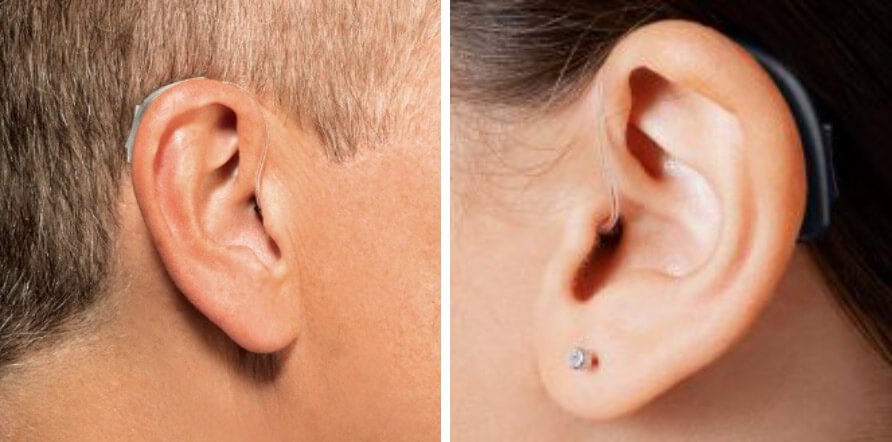
Power Behind-the-Ear (P-BTE)
- These hearing aids are intended for severe to profound hearing losses and are typically more visible than other devices. They use a custom earmold with a thick tube to allow for high levels of amplification. Most have similar features to RIC hearing aids and similar performance capabilities.
- They are primarily implemented with children and individuals who cannot use RIC hearing aids. BTE hearing aids are available in Power, Super Power, and Ultra Power options, depending on the amount of amplification they need to provide to accommodate your severity of hearing loss.
Hearing Aids for Single-Sided Deafness
If you have little to no usable hearing on one ear and usable hearing on the other, you may be a candidate for a CROS hearing aid. A CROS hearing aid sends sound from your “bad” ear to your “good” ear using wireless audio streaming. If you have some hearing loss in the good ear, you’ll need a BiCROS setup, which works like a CROS, but adds amplification to the good ear to accommodate for hearing loss on that side.
Hearing Aid Type: In-the-Ear
There are five types of in-the-ear hearing aids, ranging from the invisible-in-the-canal to the full shell in-the-ear hearing aid:
- Suited for mild to severe hearing loss
- The smallest style is virtually invisible inside the ear
- The full shell style fits inside the outer bowl of the ear
- All types are custom-made to suit the shape of your ear, ensuring optimal comfort and sound quality
- Some models offer Bluetooth® technology so you can stream sound from your phone, computer or TV
What are In-the-Ear Hearing Aids?
In-the-ear hearing aids (ITE) are the most discreet hearing aid styles available. This discreet style has no external wires or tubes visible, as opposed to behind-the-ear hearing aids. ITE hearing aids are all custom-made, ensuring both a perfect fit and a discreet look.
4 Facts About In-the-Ear Hearing Aids
- Discreet and less noticeable than other hearing aid types
- May be susceptible to earwax and moisture build-up
- Rarely available with rechargeable batteries
- Can include Bluetooth® streaming and telecoil features
In the Canal (ITC) Hearing Aids (No iPhone Connectivity)
An ITC hearing aid fits into the ear canal opening. It is barely noticeable while providing enough power for many forms of moderate-to-severe hearing loss. But because of its small size, feedback can be a problem.
ITCs work for moderate to severe hearing loss but are not recommended for profound hearing loss.
PROS:
- Very small and practically invisible
- Most discreet hearing aid style
- ITC works with directional microphones
- Easy to use with a phone
CONS:
- More difficult to adjust and remove
- Prone to moisture and earwax buildup
- Not appropriate for profound hearing loss
- CIC is too small for directional microphones
Full Shell In-the-Ear
- Custom-made to fit the entire area of your outer ear
- Provides high-quality sound amplification
- Longer battery life than smaller models
- More suitable for severe hearing loss (when compared to smaller models)
- Easy to handle
- Additional, high-tech features make it more versatile
Extended Wear Invisible-In-the-Canal (IIC)
- Invisible-in-the-canal hearing aids
- Completely-in-the-canal hearing aids
- Adapt automatically to the sound environment
- Have a discreet style
- Resistant to minimal amounts of water exposure. Can be vulnerable to earwax and moisture build-up
- Are better for minimizing wind noise (due to their placement)
- Do not have a directional microphone
- Can be difficult to adjust for those with dexterity issues
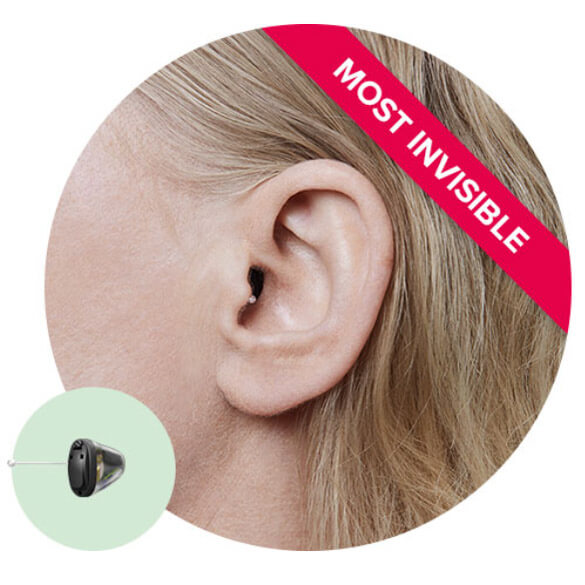
These types are considered to be the most nearly invisible hearing aids available. Since they sit completely inside your ear canal, people are unlikely to notice them.
Daily Wear Invisible-in-Canal (IIC)
The daily wear version of an IIC hearing aid is nearly as invisible as its extended wear counterpart but is inserted and removed each day by the wearer. Most IIC’s are custom molded and are primarily intended for individuals with mild to moderate hearing loss. They do have some limited controls, but often function without many adjustments from the user.

Completely-In-the-Canal (CIC) Hearing Aids
- Custom-made to fit discreetly inside the ear canal
- Very small and discreet hearing aid
- Practically invisible to other people
- Custom-designed to fit discreetly in your ear canal
- Option to manually control settings in different environments
- Can be vulnerable to earwax and moisture build-up
- Need adequate ventilation when they are used

In-the-Canal (ITC) Hearing Aids
ITC hearing aids sit in the lower third of your external ear and are custom-made to fit your ear canal shape.
- Offer slightly longer battery life than other in-the-ear styles
- Feature wireless streaming in some models
- Balance out background noise (via a directional microphone)
- Easy to insert and remove
- Bluetooth and push button controls
- Are slightly larger than completely-in-the-canal hearing aids
- Have a discreet design

Half Shell In-the-Ear (ITE) Hearing Aids
Half shell in-the-ear hearing aids are designed to fit inside half of your external ear region. The shell of the hearing aid is made to fit the shape of your ear. Half shell in-the-ear hearing aids:
- Relatively discreet
- Longer battery life than in-the-canal hearing aids
- Suitable for more severe hearing loss
- Can house additional, high-tech features
- Custom-made to fit half of your external ear
- Easy to handle
- Additional, high-tech features make it more versatile

Full Shell In-the-Ear (ITE) Hearing Aids
Full shell in-the-ear hearing aids are designed to fit the entire area of your external ear. These types of hearing aids are the largest of the custom models, due to the fact that they have larger amplifiers for providing greater sound amplification. The shell is custom-made to fit the shape of your ear.
- Fill the entire concha bowl - Relatively discreet
- Have a longer battery life than in-the-canal hearing aids
- Suitable for anyone with a more severe hearing loss
- Good option if you want an easy-to-handle device
- Can house additional, high-tech features


